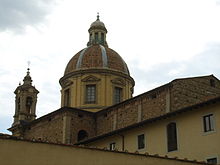San Frediano in Cestello: Difference between revisions
Vegaswikian (talk | contribs) m →References: More specific category |
|||
| Line 59: | Line 59: | ||
==References== |
==References== |
||
| ⚫ | |||
*{{cite book | first= Eve|last= Borsook| year=1991| title= ''The Companion Guide to Florence''| publisher= Harper Collins| editor= Vincent Cronin (general editor)| id=ISBN 000215139-1 | url= | authorlink= |pages= page 322}} |
*{{cite book | first= Eve|last= Borsook| year=1991| title= ''The Companion Guide to Florence''| publisher= Harper Collins| editor= Vincent Cronin (general editor)| id=ISBN 000215139-1 | url= | authorlink= |pages= page 322}} |
||
| ⚫ | |||
| ⚫ | |||
{{DEFAULTSORT:Frediano In Cestello, San}} |
{{DEFAULTSORT:Frediano In Cestello, San}} |
||
[[Category:Buildings and structures completed in 1689]] |
|||
| ⚫ | |||
[[Category:17th-century church buildings]] |
|||
[[Category:Churches in Florence]] |
[[Category:Churches in Florence]] |
||
[[Category:1680s architecture]] |
|||
Revision as of 20:48, 2 April 2015
| Church of Saint Fridianus (Chiesa di San Frediano in Cestello) | |
|---|---|
 Dome and bell tower of San Frediano. | |
| Religion | |
| Affiliation | Roman Catholic |
| Province | Florence |
| Location | |
| Location | Florence, Italy |
| Geographic coordinates | 43°46′11.97″N 11°14′38.28″E / 43.7699917°N 11.2439667°E |
| Architecture | |
| Architect(s) | Gherardo Silvani; Giulio Cerutti; Antonio Maria Ferri |
| Type | Church |
| Groundbreaking | 1680 |
| Completed | 1689 |

San Frediano in Cestello is a church in the Oltrarno section of Florence, Tuscany, Italy.
The name cestello derives from the Cistercians who occupied the church in 1628. Previously the site had a 1450s church attached to the cloistered Carmelite convent of Santa maria degli Angeli.
In 1680-1689, the church was rebuilt on the designs of Gherardo Silvani and Giulio Cerutti. The imposing cupola and bell tower added in 1689 by Antonio Maria Ferri.
In the former convent of the site lived and died Saint Magdalena de Pazzi (1566–1607), born to a noble Florentine family. She was renowned for her ecstasies, during which she had visions of the divine will favoring church reforms. She was canonized by 1662. Her body was transferred to the church in central Florence that bears her name.
The interior is frescoed with a Glory of the Magdalen and Virtue (1702–1718) by Antonio Domenico Gabbiani. The cloisters contain a statue of St. Maria Maddalena de' Pazzi (1726) by Antonio Montauti and a St. Bernard of Clairvaux defeats the devil (1702) by Giuseppe Piamontini (1702). The latter cloister was designed by Gherardo and Piefrancesco Silvani.
The refectory has a Last supper and a painting by Bernardino Poccetti. In the transept is a Madonna in glory with saints by Francesco Curradi and a painting of a Crucifixion with saints and Martyrdom of St. Lawrence (late 15th century) by Jacopo del Sellaio. In the third chapel to the left, is a polychrome wooden Madonna and child (1350) by a follower of Nino, the son of Andrea Pisano, and frescoes of the Scenes from the life of the founder of the Cistercian order (1688–1689) by Pier Dandini.

